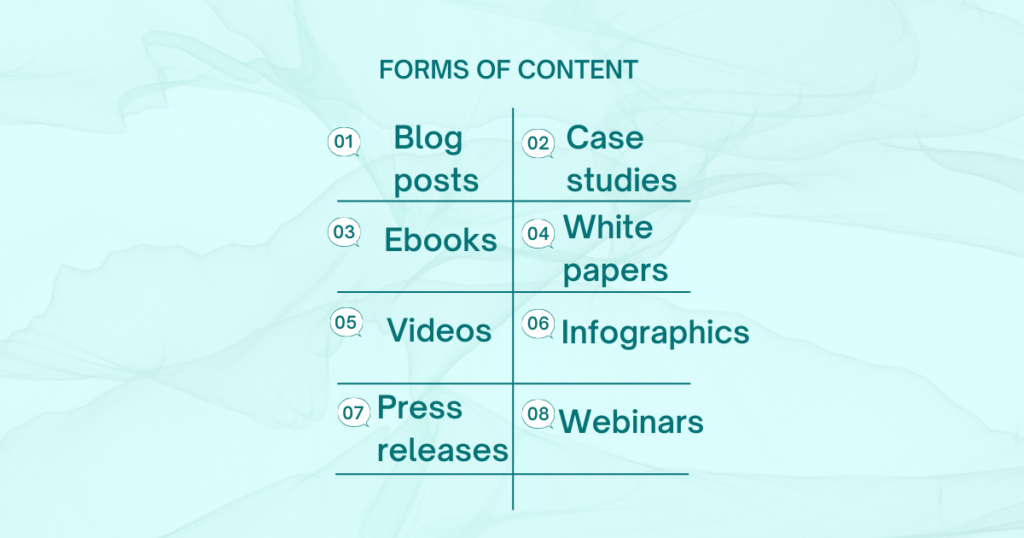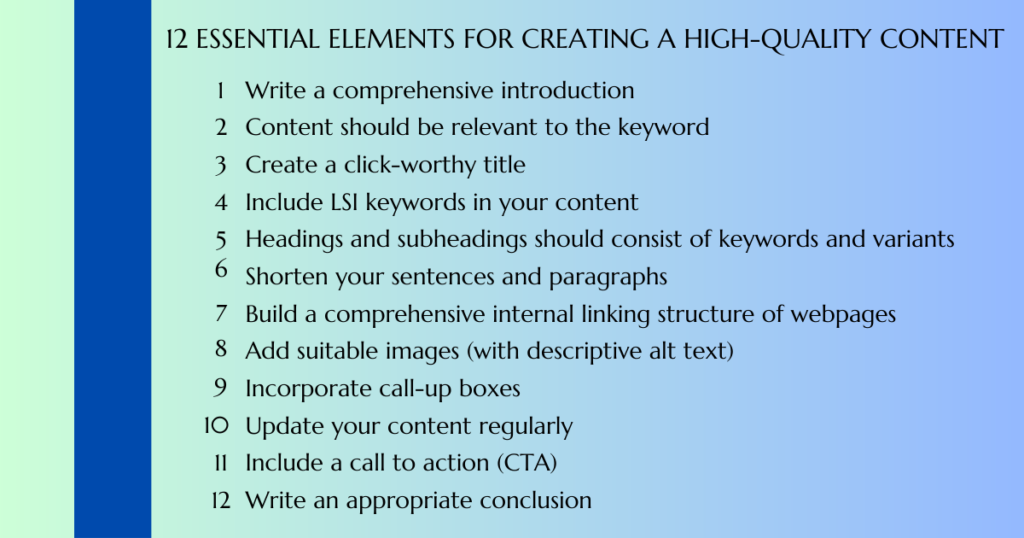In today’s digital age, creating high-quality content has become crucial to grab your target audience’s attention and to drive traffic to your website.
Everyone wants a top spot on the top search engine in the world. But there are very important things you must do for every other SEO strategy to work effectively. One very important thing you must do is to create high-quality content.
In this post, we are going to look at
- Creating high-quality content
- Best practices for creating quality content
- Essential elements for creating a high-quality content
CREATING HIGH-QUALITY CONTENT
When we talk about the impact quality content has on your ability to get your website ranked number 1 on Google, the benefits are too juicy to be placed as a secondary option.
Let’s say you have content on your website, which ranks on page 4 of Google, and it’s a blog post with ice cream recipes. If it’s just content for the sake of content that is not really informative, then it’s not necessarily going to get good engagement in the eyes of Google.
Google wants to rank content that is very informative, fresh, exciting to read, engaging and meets Google’s search quality rater guidelines. Such content is going to have good engagement.
Google’s search quality rater guideline states that you must demonstrate E-E-A-T in your content strategy. E-E-A-T stands for experience, expertise, authoritativeness, and trust. If the content you create does not meet the rater guideline, then it’s just not informative, and you are not going to get good engagement.
When you don’t get good engagement, if people don’t stay on the site to engage in the content and leave the website after landing on the page, causing a bounce, the content will continue to fall down the rankings. We want to prevent that, move up the rankings, be number one on Google, and not fall on the rankings for our content.
Content is a key driver in ranking number one on Google. If you have quality content and the content is on page nine, you want to be able to take that content and do something with it. If you feel that you did write engaging content, then go ahead and draw backlinks and traffic to it.
One way to do this is to share it on social media. Social media is a good platform to share your content because you can build a community on social media platforms like Facebook. That community is already interested in your content and is going to increase engagement.
Increased engagement will send social signals to the search engine that says this content is good quality, likewise for any other platform. Most social media platforms have engagement metrics, which pass signals showing whether the content is good.
These metrics show if people like this content by how they are giving it a thumbs up, following you, and sharing it.
Once you share quality content, it’s likely going to cause an increase in engagement and a decrease in bounces, and then the likelihood of it moving up the rankings, even as far as number one on Google, is going to be greater.
Always start out writing good-quality content. High-quality content is the most important factor that helps your website to rank on Google. Google takes content seriously. They take into account what other people think of that content.
BEST PRACTICES FOR CREATING QUALITY CONTENT
The question is always about how to create good content. Some of the best practices are as follows:
Perform research for your chosen keyword
Keywords are important words or sentences found in a research question. Keyword research is the process of finding and analyzing search terms that people enter into search engines with the goal of using that data to understand the search intent for the target keyword.
Remember you are choosing/targeting multiple keywords per page. One keyword could be related to our brand, one could be related to the content, and another could be related to a user’s intent.
Let’s take bread recipes, for example; maybe somebody is looking for ‘how to make a piece of bread’ or ‘how to make banana bread’ or ‘what’s the best recipe for banana bread.’
They are related questions, and we want to be able to answer those questions, so that’s where choosing the right keywords will respond to a user’s intent. You can use several different tools to do keyword research, e.g., Ahrefs or phrase.io. It will help you quickly research keywords and trends and whatnot.
Create content that fulfills user’s requirements
Keyword research is key for creating content that fulfills users’ requirements. Answering the searcher’s questions in detail is the primary purpose your content should satisfy. If it’s a recipe, your content should mention it in detail; if it’s directions, your content should give it in detail; if they don’t know how to do something, you should answer it.
That’s the whole idea behind content. Content is not just to fill a page. It’s to fulfill users’ requirements. That’s when you get good engagement. If somebody is typing in something on Google and they are looking for an answer, your content should answer that question.
Make the content readable

Write for your audience. Don’t impress anybody with a very high vocabulary or words; your audience will leave your page and look for meaning elsewhere. Write in a way your audience will understand; don’t use jargon, and don’t use street language. Use common everyday language that’s easily digestible when your audience reads.
Keep your content flow organized
To keep your content flow organized means to use headers and subheaders and also break your content into paragraphs. Keeping the flow organized will make it easier for the audience to read. It’s okay to add resources, especially resources from credible sites. It helps add value to your content.
Incorporating those resources will add credibility to your content and let the audience know that you have researched the topic and this is what this person has to say about it.
Opt for white heart techniques
when you have chosen keywords that you want to target to answer searchers’ queries, you don’t have to stuff those keywords into the content. Write the content naturally and let it flow with complete details to answer the searcher’s query. Totally avoid going against the search engine guidelines in any way.
Prefer different forms of content

There are different types of content. There are contents where you write words; you can also use infographics to visualize what you are trying to explain. For example, if we want to write an article about how to write good engaging content, we don’t necessarily have to write all that out as a text. We can create an infographic.
Infographics tend to be easier to understand because they are visual. They are easy for the end user to comprehend because there is generally no jargon. It’s usually images that portray the points of what you are trying to get across, and so it tends to break up the monotony of just text. Infographics are more visually appealing, are laid out and organized, and can be shared on social media. Infographics tend to tell a better story than just writing text.
You can use video and images. You don’t necessarily have to lay it all out in an infographic; you can insert a video or an image into your content, especially if it’s a blog post. If it is a blog post, sometimes videos and images tell the story. You don’t necessarily need text to go ahead and tell your story. As they say, a video or an image speaks a thousand words, so images and videos are great to use in a blog post.
Review your content
Reviewing your content regularly to see what works best, what areas need adjustment, and what doesn’t work for you. This way, you will be able to produce better content with higher engagement.
When a user dwells on a webpage for a longer time, Google will tend to think this person is engaged, so they are going to rank that favorably. Suppose you use infographics, videos, and images. In that case, the chances of your readers being more engaged will increase versus just text that’s poorly organized and written out in a way that is difficult to understand.
Be creative in the types of content you use. Longer engaging content tends to bode well with search engines, according to HubSpot. The more word counts you have, the higher your chances of ranking higher. Break up the content with an image, organize it, make it engaging, and use headers.
Blog posts are not necessarily just words; it’s the words and how they are written, how they are structured, the types of keywords you use, and how you engage with the audience. There are a lot of factors, and there are best practices like the ones we just went over. But the key here is that if you have longer, more engaging content, it will bode better for you on search engines.
12 Essential Elements For Creating A High-Quality Content

Write a comprehensive introduction
Always introduce your content by establishing the min idea, purpose, and direction of the content. With a proper and comprehensive introduction, you will be able to gain the reader’s attention and provide all the necessary background information.
Content should be relevant to the keyword
If you are choosing keywords during your keyword research, think about answering that question. If somebody is typing in bread recipes, they may be looking for banana bread recipes, how to make the best banana bread, and how to make it using dried figs. You should be able to align your content with that keyword naturally.
Create a click-worthy title
Your title should be catchy and attention-grabbing to draw people’s attention. Put yourself in the searcher’s shoes to craft better and click-worthy titles.
Suppose you are in a Google search and you are doing a search for something simple like bread recipes. In that case, you should make something instantly appealing and memorable for someone to click on, like easy perfect yeast bread, easy crusty French bread, the best bread recipe, or how to make the best homemade bread. Anything that is going to be engaging. Make sure it will draw the reader’s attention to the title of that blog post.
Include LSI keywords in your content
Latent semantic indexing(LSI) keywords are words and phrases that are commonly related to your primary keyword. LSI keywords assist search engines in determining the intent of your Web page. This makes it easier for users to find Web pages with relevant content to their search term. Relevant content helps to increase the number of visitors to your website organically.
Headings and subheadings should consist of keywords and variants
Headers and subheaders are essential components of a well-structured piece of content. They provide search engines and readers with a clear indication of the content, allowing them to navigate the text easily. If you are writing headers and subheaders, include the keyword in there. That way, the content always stays relevant to the audience.
Shorten your sentences and paragraphs
Always convey information in a clear and concise manner. It’s crucial to strike a balance between being succinct and providing the necessary details to ensure understanding.
One way to achieve this balance is to break up your content into smaller, more digestible chunks. By breaking up your content in this way, it becomes easier for the reader to scan and absorb the main points without feeling overwhelmed.
Build a comprehensive internal linking structure of webpages
If you have a link from one blog post to another, make sure it is between two relevant pieces of content. That way, search engines, and readers can easily access related and relevant pages for further reading. Internal linking will help keep the end user engaged because you are offering relevant links to related content.
Add suitable images (with descriptive alt text)
It’s important to ensure that your content is visually appealing and accessible to all users. One way to achieve this is by adding images throughout your content and using proper alt text to describe them. Alt text, or alternative text, is a brief description of an image that screen readers read for visually impaired users. Also, if the image doesn’t load, the alt text will load for readers. It is an important SEO factor. Make sure it is short and descriptive.
Incorporate call-up boxes
Incorporating call-up boxes is a highly effective strategy to capture the attention of your website visitors and encourage them to engage with your content. By strategically placing call-up boxes throughout your website, you can increase your conversion rates and build your email list.
Update your content regularly
You should always keep your blog post fresh by updating it regularly. Regular updates keep your audience engaged and informed and help establish your brand as an industry leader. Additionally, fresh content is essential for search engine optimization (SEO) and can improve your website’s ranking on search engines.
Include a call to action (CTA)
In order to engage your audience and encourage them to take the desired action, it is crucial to include a call to action (CTA) in your content. A CTA prompts the reader to take a specific action, such as signing up for a newsletter, making a purchase, or contacting your business.
By including a clear and compelling CTA, you can increase the likelihood of conversion and drive more traffic to your website or business.
Write an appropriate conclusion
A conclusion gives the reader a brief closing remark while reminding them of the paper’s contents and importance. It achieves this by stepping back from the specifics to see the big picture of the document.
You can give professional tips in the conclusion paragraph as well.
Some do’s and don’ts of the content
The do’s
- Research your topic and target audience and create content that speaks to their needs and interests.
- Use catchy headlines and engaging visuals to grab your audience’s attention.
- Create high-quality, original content that adds value to your audience.
- Use clear and concise language that is easy to understand.
- Make sure your content is relevant and adds value to your audience.
- Include calls to action to encourage engagement and interaction with your audience.
- Optimize your content for search engines with relevant keywords and meta descriptions.
- Proofread and edit your content for grammar, spelling, and punctuation errors.
- Promote your content through social media and other channels to reach a wider audience.
The don’t
- Don’t plagiarize or use copyrighted material without permission.
- Don’t use overly complex language that your audience won’t understand.
- Don’t create irrelevant or misleading content.
- Don’t ignore your target audience’s needs and preferences.
- Don’t overload your content with too many keywords.
FINAL THOUGHTS
Creating content that ranks on Google may seem like a daunting task for beginners, but it is achievable with the right approach. By implementing the tips discussed in this blog post, you will be able to increase your online presence and build your business’s credibility.
Again, this is just your starting point to creating content that ranks on search engines.
You can iterate on it, tweak it, and optimize it for better results. And, of course, tailor it to your business’s needs. And if you’re uncertain about how to execute your business content, Thriving Smart can help you with your content creation and other digital marketing projects.